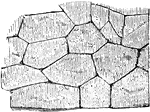Clipart tagged: ‘mycenaean architecture’

Cyclopean Masonry
Remains of the circular walls round towns and palaces, which are known under the name Cyclopean, exist…

The Lion Gate at Mycenæ
Remains of the circular walls round towns and palaces, which are known under the name Cyclopean, exist…

Pillar Fragment from the Treasury of Atreus
Peculiar vaulted buildings often existed in connection with the palaces for the preservation of valuables;…

Section of the Treasury of Atreus
Peculiar vaulted buildings often existed in connection with the palaces for the preservation of valuables;…